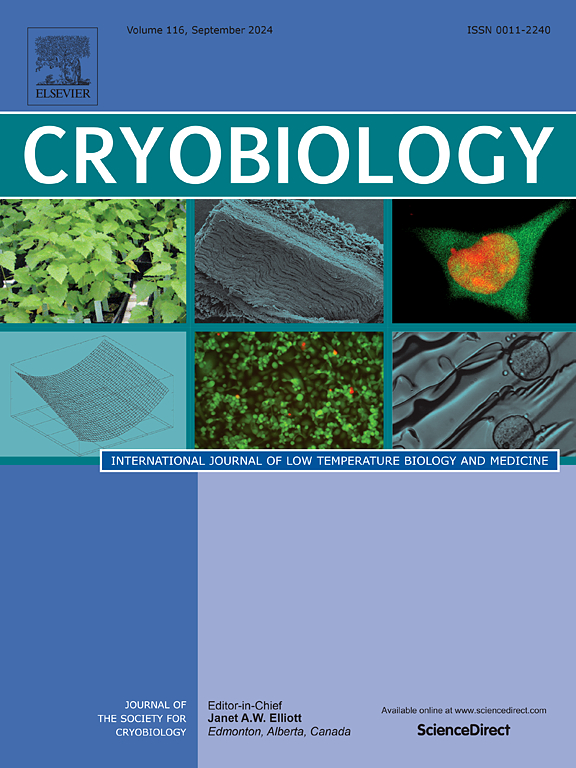Evaluation of the effect of human testicular cell conditioned media on the in vitro development of follicles from cryopreserved human ovarian cortical pieces. A potential approach for fertility preservation for cancer patients
IF 2.1
3区 生物学
Q2 BIOLOGY
引用次数: 0
Abstract
If in vitro culture conditions could be improved, in vitro growth of cryopreserved ovarian tissue and isolated follicles could become an alternative to ovarian tissue transplantation. This study evaluated two cryopreservation methods, slow cooling and vitrification, and two in vitro culture methods, to determine their effect on the in vitro growth of human ovarian follicles. After warming, the OT pieces (1 × 10 × 3 mm) were cultured in either routine culture medium (DMEM), or DMEM supplemented 50:50 with media previously used for human testicular cell culture (hTCCM) to serve as a source of growth factors. Several parameters were evaluated during culture including follicle recruitment, growth, morphology, diameter, hormone production, and gene expressions (PTEN, BMP-15, PDGF, GDF-9, and GAPDH). The follicular morphology and hormonal secretion were comparable for both cryopreservation methods and both culture methods (P > 0.05). Follicle recruitment was accelerated in the vitrified group, in the presence of hTCCM (P > 0.05). After 7 days of culture, the follicle diameter was greater in the slow/hTCCM compared to the vitrification DMEM group. Similarly only one gene expression profile, BMP-15, in the slow/hTCCM differed significantly from another treatment group (Vit DMEM). At the end of culture (over 21 days), three immature, low-quality oocytes were the achievement. In conclusion, a very quick and easy vitrification protocol gave comparable results to the slow cooling method. We also established that the laboriously prepared hTCCM supplement did not benefit the outcomes. Further work is needed before in vitro maturation of cryopreserved ovarian cortical pieces can be used clinically.

人睾丸细胞条件培养基对冷冻保存的人卵巢皮质片卵泡体外发育影响的评价。癌症患者保留生育能力的潜在方法
如果能改善体外培养条件,体外培养冷冻卵巢组织和分离卵泡可能成为卵巢组织移植的替代方法。本研究评估了两种低温保存方法,缓慢冷却和玻璃化,以及两种体外培养方法,以确定它们对人卵巢卵泡体外生长的影响。加热后,OT片(1 × 10 × 3 mm)分别在常规培养基(DMEM)中培养,或在DMEM中添加50:50的原人睾丸细胞培养培养基(hTCCM)作为生长因子来源。在培养过程中评估几个参数,包括卵泡招募、生长、形态、直径、激素产生和基因表达(PTEN、BMP-15、PDGF、GDF-9和GAPDH)。冷冻保存方法和培养方法的卵泡形态和激素分泌相似(P >;0.05)。在hTCCM存在的情况下,玻璃化组的卵泡再生加速(P >;0.05)。培养7天后,与玻璃化DMEM组相比,慢速/hTCCM组的卵泡直径更大。同样,在慢速/hTCCM中,只有一个基因表达谱BMP-15与另一个治疗组(Vit DMEM)有显著差异。在培养结束时(超过21天),获得3个未成熟的低质量卵母细胞。总之,一个非常快速和简单的玻璃化方案给出了与缓慢冷却方法相当的结果。我们还确定,辛苦制备的hTCCM补充剂对结果没有好处。在体外成熟冷冻卵巢皮质片用于临床之前,还需要进一步的工作。
本文章由计算机程序翻译,如有差异,请以英文原文为准。
求助全文
约1分钟内获得全文
求助全文
来源期刊

Cryobiology
生物-生理学
CiteScore
5.40
自引率
7.40%
发文量
71
审稿时长
56 days
期刊介绍:
Cryobiology: International Journal of Low Temperature Biology and Medicine publishes research articles on all aspects of low temperature biology and medicine.
Research Areas include:
• Cryoprotective additives and their pharmacological actions
• Cryosurgery
• Freeze-drying
• Freezing
• Frost hardiness in plants
• Hibernation
• Hypothermia
• Medical applications of reduced temperature
• Perfusion of organs
• All pertinent methodologies
Cryobiology is the official journal of the Society for Cryobiology.
 求助内容:
求助内容: 应助结果提醒方式:
应助结果提醒方式:


